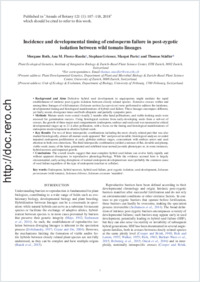Incidence and developmental timing of endosperm failure in post-zygotic isolation between wild tomato lineages
- Roth, Morgane Plant Ecological Genetics, Institute of Integrative Biology & Zurich–Basel Plant Science Center, ETH Zurich, Switzerland
- Florez-Rueda, Ana M. Plant Ecological Genetics, Institute of Integrative Biology & Zurich–Basel Plant Science Center, ETH Zurich, Switzerland - Plant Developmental Genetics, Department of Plant and Microbial Biology & Zurich–Basel Plant Science Center, University of Zurich, Switzerland
- Griesser, Stephan Plant Ecological Genetics, Institute of Integrative Biology & Zurich–Basel Plant Science Center, ETH Zurich, Switzerland
- Paris, Margot Plant Ecological Genetics, Institute of Integrative Biology & Zurich–Basel Plant Science Center, ETH Zurich, Switzerland - Unit of Ecology & Evolution, Department of Biology, University of Fribourg, Switzerland
- Städler, Thomas Plant Ecological Genetics, Institute of Integrative Biology & Zurich–Basel Plant Science Center, ETH Zurich, Switzerland
-
25.01.2018
Published in:
- Annals of Botany. - 2018, vol. 121, no. 1, p. 107–118
English
Background and AimsDefective hybrid seed development in angiosperms might mediate the rapid establishment of intrinsic post-zygotic isolation between closely related species. Extensive crosses within and among three lineages of wild tomatoes (Solanum section Lycopersicon) were performed to address the incidence, developmental timing and histological manifestations of hybrid seed failure. These lineages encompass different, yet fairly recent, divergence times and both allopatric and partially sympatric pairs.MethodsMature seeds were scored visually 2 months after hand pollinations, and viable-looking seeds were assessed for germination success. Using histological sections from early-developing seeds from a sub-set of crosses, the growth of three major seed compartments (endosperm, embryo and seed coat) was measured at critical developmental stages up to 21 d after pollination, with a focus on the timing and histological manifestations of endosperm misdevelopment in abortive hybrid seeds.Key ResultsFor two of three interspecific combinations including the most closely related pair that was also studied histologically, almost all mature seeds appeared ‘flat’ and proved inviable; histological analyses revealed impaired endosperm proliferation at early globular embryo stages, concomitant with embryo arrest and seed abortion in both cross directions. The third interspecific combination yielded a mixture of flat, inviable and plump, viable seeds; many of the latter germinated and exhibited near-normal juvenile phenotypes or, in some instances, hybrid necrosis and impaired growth.ConclusionsThe overall results suggest that near-complete hybrid seed failure can evolve fairly rapidly and without apparent divergence in reproductive phenology/biology. While the evidence accrued here is largely circumstantial, early-acting disruptions of normal endosperm development are most probably the common cause of seed failure regardless of the type of endosperm (nuclear or cellular).
- Faculty
- Faculté des sciences et de médecine
- Department
- Département de Biologie
- Language
-
- English
- Classification
- Biological sciences
- License
-
License undefined
- Identifiers
-
- RERO DOC 306709
- DOI 10.1093/aob/mcx133
- Persistent URL
- https://folia.unifr.ch/unifr/documents/306346
Statistics
Document views: 88
File downloads:
- pdf: 206
